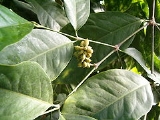
Gnetum
Encyclopedia
Gnetum is a genus of about 30-35 species of gymnosperm
s, the sole genus in the family Gnetaceae and order Gnetales. They are tropical evergreen
tree
s, shrub
s and liana
s. Unlike other gymnosperms they possess vessel elements in the xylem
. Some species have been proposed to have been the first plants to be insect pollinated as they occur in association with the extinct pollinating scorpionflies.
s being roasted, and the foliage used as a leaf vegetable
. Some are also valued in herbal medicine.
Gymnosperm
The gymnosperms are a group of seed-bearing plants that includes conifers, cycads, Ginkgo, and Gnetales. The term "gymnosperm" comes from the Greek word gymnospermos , meaning "naked seeds", after the unenclosed condition of their seeds...
s, the sole genus in the family Gnetaceae and order Gnetales. They are tropical evergreen
Evergreen
In botany, an evergreen plant is a plant that has leaves in all seasons. This contrasts with deciduous plants, which completely lose their foliage during the winter or dry season.There are many different kinds of evergreen plants, both trees and shrubs...
tree
Tree
A tree is a perennial woody plant. It is most often defined as a woody plant that has many secondary branches supported clear of the ground on a single main stem or trunk with clear apical dominance. A minimum height specification at maturity is cited by some authors, varying from 3 m to...
s, shrub
Shrub
A shrub or bush is distinguished from a tree by its multiple stems and shorter height, usually under 5–6 m tall. A large number of plants may become either shrubs or trees, depending on the growing conditions they experience...
s and liana
Liana
A liana is any of various long-stemmed, woody vines that are rooted in the soil at ground level and use trees, as well as other means of vertical support, to climb up to the canopy to get access to well-lit areas of the forest. Lianas are especially characteristic of tropical moist deciduous...
s. Unlike other gymnosperms they possess vessel elements in the xylem
Xylem
Xylem is one of the two types of transport tissue in vascular plants. . The word xylem is derived from the Classical Greek word ξυλον , meaning "wood"; the best-known xylem tissue is wood, though it is found throughout the plant...
. Some species have been proposed to have been the first plants to be insect pollinated as they occur in association with the extinct pollinating scorpionflies.
Species
- Gnetum sect. Gnetum
- Gnetum subsect. Gnetum - 2 species of trees; southeast AsiaAsiaAsia is the world's largest and most populous continent, located primarily in the eastern and northern hemispheres. It covers 8.7% of the Earth's total surface area and with approximately 3.879 billion people, it hosts 60% of the world's current human population...
- Gnetum gnemonGnetum gnemonGnetum gnemon is a species of Gnetum native to southeast Asia and the western Pacific Ocean islands, from Assam south and east through Indonesia and Malaysia to the Philippines and Fiji...
- Gnetum costatum
- Gnetum gnemon
- Gnetum subsect. Micrognemones - 2 species of lianas; tropical west AfricaAfricaAfrica is the world's second largest and second most populous continent, after Asia. At about 30.2 million km² including adjacent islands, it covers 6% of the Earth's total surface area and 20.4% of the total land area...
- Gnetum africanumGnetum africanumGnetum africanum is a popular vegetable collected in the wild throughout tropical Africa...
- Gnetum buchholzianum
- Gnetum africanum
- Gnetum subsect. Araeognemones - 9 species of lianas; tropical South AmericaSouth AmericaSouth America is a continent situated in the Western Hemisphere, mostly in the Southern Hemisphere, with a relatively small portion in the Northern Hemisphere. The continent is also considered a subcontinent of the Americas. It is bordered on the west by the Pacific Ocean and on the north and east...
and Central AmericaCentral AmericaCentral America is the central geographic region of the Americas. It is the southernmost, isthmian portion of the North American continent, which connects with South America on the southeast. When considered part of the unified continental model, it is considered a subcontinent...
- Ituá- Gnetum amazonicum
- Gnetum camporum
- Gnetum leyboldii
- Gnetum nodiflorum
- Gnetum paniculatum
- Gnetum schwackeanum
- Gnetum urens
- Gnetum venosum
- Gnetum subsect. Gnetum - 2 species of trees; southeast Asia
- Gnetum sect. Scandentia - about 20 species of lianas; southern Asia
- Gnetum subsect. Stipitati
- Gnetum arboreum
- Gnetum contractum
- Gnetum gracilipes
- Gnetum latifolium
- Gnetum montanum
- Gnetum oblongum
- Gnetum pendulum
- Gnetum tenuifolium
- Gnetum ula
- Gnetum subsect. Sessiles
- Gnetum acutum
- Gnetum bosavicum
- Gnetum cleistostachyum
- Gnetum cuspidatum
- Gnetum diminutum
- Gnetum globosum
- Gnetum gnemonoides
- Gnetum hainanense
- Gnetum klossii
- Gnetum leptostachyum
- Gnetum loerzingii
- Gnetum luofuense
- Gnetum macrostachyum
- Gnetum microcarpum
- Gnetum neglectum
- Gnetum oxycarpum
- Gnetum parvifolium
- Gnetum raya
- Gnetum ridleyi
- Gnetum subsect. Stipitati
Uses
Many Gnetum species are edible, with the seedSeed
A seed is a small embryonic plant enclosed in a covering called the seed coat, usually with some stored food. It is the product of the ripened ovule of gymnosperm and angiosperm plants which occurs after fertilization and some growth within the mother plant...
s being roasted, and the foliage used as a leaf vegetable
Leaf vegetable
Leaf vegetables, also called potherbs, green vegetables, greens, leafy greens or salad greens, are plant leaves eaten as a vegetable, sometimes accompanied by tender petioles and shoots...
. Some are also valued in herbal medicine.

